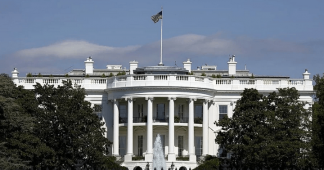By Eric London
Nov. 6, 2020
An initial examination of the voting data in the 2020 presidential election exposes as false the racialist narrative of American politics that is relentlessly promoted by the Democratic Party. Several aspects of the election data are particularly significant in showing the predominance of socioeconomic factors in the outcome.
A comparison of the results of the 2016 and 2020 elections shows that the major factor that turned the election was the impact of the pandemic and the economic crisis on a substantial section of working class whites who cast their vote for Biden.
There was a substantial increase in turnout in the working class as well as sections of the lower-middle class hard hit by the coronavirus pandemic. This helped Biden widen the margin of his popular vote victory, which is expected to rise to an estimated six or seven million votes—double the margin by which Clinton beat Trump in 2016. Over 66 percent of eligible voters cast votes this year, the highest turnout rate since 1900, before women had the right to vote. Turnout had not reached 60 percent since 1968, when it was 60.7 percent.
There was a pronounced increase of votes against Trump among men, white men and whites without a college degree. In states that were decimated by the coronavirus pandemic—including Wisconsin, Michigan and Arizona—this shift among white men accounted for Biden flipping the state.
Biden won the votes of an estimated 8.6 million more men (of all races) than Hillary Clinton did in 2016, while Trump’s vote among men increased by roughly 2.2 million from 2016. Among all white voters, Trump won 57 percent of the vote, the same as in 2016. Biden, however, won 42 percent of white voters, an increase from the 37 percent won by Clinton in 2016. Overall, an estimated 6.4 million more white people voted for the Democrat in 2020 than in 2016.
Among white men, Trump suffered a slight decline in 2020, winning an estimated 28.77 million votes in 2020, down from 28.83 in 2016, despite the overall increase in white male turnout. While Biden still failed to win a majority of this cohort overall, he won roughly 5.4 million more votes from white men than Clinton won in 2016.
In 2020, both Trump and Biden increased their votes from white people without college degrees. While Trump was supported by an estimated 3.1 million more such voters in 2020 than in 2016, Biden turned out roughly five million more than Clinton did. In other words, Biden won the votes of “new” voters in this category by a 60-40 margin. Trump’s share of the vote fell slightly from 2016, while the Democratic share increased from 29 to 35 percent.
The 2020 results also show a shift against Trump in the working class.
There were roughly 23 million more votes cast for either Biden or Trump by voters with family incomes below $100,000 than were cast for Clinton or Trump in 2016. Among workers with family incomes less than $50,000, Trump won an estimated 2.1 million more votes than he did in 2016, but Biden won 4.9 million more than Clinton. This increased the share going to the Democrats from 53 percent in 2016 to 57 percent in 2020.
Among the wealthier cohort, Trump significantly increased his support. In 2016, Clinton and Trump tied among those with family incomes above $100,000, with each winning roughly 21.8 million votes. But in 2020, several million affluent people switched their support to Trump. Wealthier voters supported Trump because his policy of “herd immunity” has fed the rising stock market and enriched this layer.
But as a share of the electorate, voters with family incomes over $100,000 declined substantially from 34 percent to 28 percent, an estimated 3 million vote decline from 2016 to 2020.
This is not so much the product of a decline in turnout among the rich, who always vote with far higher consistency. It primarily reflects the worsening economic position of substantial sections of the working class and lower-middle class, who went from having family incomes above $100,000 in 2016 to the $50,000-$100,000 range in 2020. This layer, seriously impacted by mass unemployment caused by the pandemic, now makes up 38 percent of the electorate, a massive increase from 30 percent in 2016.
The “new” voters in the $50,000-$100,000 category (that is, those who either were in the higher bracket in 2016 or did not vote for either of the two main parties in 2016) cast an estimated 14.1 million votes for Biden versus 5.2 million for Trump. While Trump won the $50,000-$100,000 category by a 49-46 percent margin in 2016, Biden won it in 2020 by a 56-43 margin.
Particularly significant is the fact that Trump substantially increased support among women, the rich, and wealthier sections of the African-American, Latino, Asian-American and LGBT populations.
Among African-American men, Trump increased his share of the vote from 13 percent in 2016 to 18 percent in 2020, accounting for an increase of roughly 500,000 overall votes. Democrats increased black male turnout by only some 600,000, meaning Trump and the Democrats split all “new” African-American male votes almost 50-50.
Among African-American women, Trump more than doubled both his vote total and his share of the vote. Trump won just four percent of African-American women in 2016, a total of about 383,000 votes. In 2020, Trump won eight percent, or 868,000 votes. These are unprecedented gains.
While exit polls do not break down the African-American vote by income category, they do break down the overall “nonwhite” vote by education, which is the closest proxy for income available. Compared to 2016, Trump won an estimated 1.5 million more votes from this generally wealthier section of the population—a total of 5.4 million. He increased his share of the vote from 22 percent in 2016 to 27 percent in 2020.
The figures among Latino voters are similar to those for African-Americans and Asian-Americans. Among LGBT voters, Trump tripled his total vote and doubled his share of the overall LGBT vote. In 2016, Trump won roughly 950,000 votes from LGBT people—14 percent of the total, to the Democrats’ 77 percent. In 2020, Trump won about 3 million votes, or 28 percent of the total, to the Democrats’ 61 percent.
Although there was not an increase in turnout among young voters (aged 18-29), Trump lost 600,000 votes from this cohort compared with 2016, while the Democrats gained nearly two million. Young people made up slightly less of the electorate than in 2016, but the turn against Trump was very substantial.
The undermining of the racialist narrative infuriates those who make it their professional responsibility to promote racial divisions, claiming that the United States is based on “white supremacy” and that Trump is the natural representative of white men. Maintaining the racialist narrative is critical to the social interests of privileged layers of the upper-middle class that use it to advance their own interests.
The New York Times’ Charles Blow wrote a column Wednesday pointing to some of the shifts in the votes of African Americans indicated above, but concluding that it merely underscores “the power of the white patriarchy” and its ability to “reach across gender and sexual orientation and even race.” That is, Blow absurdly claims, a growing section of (wealthier) African Americans and other minorities voted for Trump in order to uphold white supremacy.
The dominant factors influencing shifts in voting patterns are socioeconomic in character, but this does not automatically mean that workers are conscious of their independent class interests. Workers are subjected to all sorts of influences and manipulations, including those voting for Trump, who in his own noxious way seeks to appeal to economic uncertainties and capitalize on hostility to the Democratic Party, which is as much the party of bank bailouts, war and social inequality as the Republicans.
The great danger is that, within the framework of the existing political system, controlled by two capitalist parties, there is no genuine expression of the social and economic interests of the vast majority of the population, the working class of all races and genders.
The task of socialists is to develop within the working class a genuine class consciousness and build a political movement based on workers’ common class interests in opposition to the capitalist system.
Published at https://www.wsws.org/en/articles/2020/11/06/pers-n06.html











